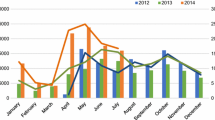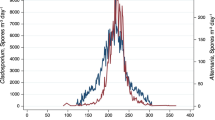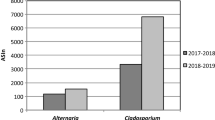Abstract
This study represents the first international intercomparison of fungal spore observations since 1990, focusing on atmospheric concentrations of Alternaria, Cladosporium, Ganoderma and Didymella spores. The campaigns were performed at sites located in Cork (Ireland) and Worcester (England) during summer 2010. Observations were made using Hirst-type volumetric spore traps and corresponding optical identification at the genus level by microscope. The measurements at both sites (including meteorological parameters) were compared and contrasted. The relationships between the fungal spore concentrations with selected meteorological parameters were investigated using statistical methods and multivariate regression trees (MRT). The results showed high correlations between the two sites with respect to daily variations. Statistically significant higher spore concentrations for Alternaria, Cladosporium and Ganoderma were monitored at the Worcester site. This result was most likely due to the differences in precipitation and local fungal spore sources at the two sites. Alternaria and Cladosporium reached their maxima a month earlier in Cork than in Worcester, and Didymella with Ganoderma peaked simultaneously with similar diurnal trends found for all the investigated spore types. MRT analysis helped to determine threshold values of the meteorological parameters that exerted most influence on the presence of spores: they were found to vary at the two sites. Our results suggest that the aeromycological profile is quite uniform over the British Isles, but a description of bioaerosols with respect to overall load and daily concentration can be quite diverse although the geographical difference between sites is relatively small. These variations in the concentrations therefore need to be explored at the national level.








Similar content being viewed by others
References
Ataygul, E., Celenk, S., Canitez, Y., Bicakci, A., Malyer, H., & Sapan, N. (2007). Allergenic fungal spore concentrations in the atmosphere of Bursa, Turkey. Journal of Biological & Environmental Sciences, 1(2), 73–79.
Breitenbach, M., Crameri, R., & Lehrer, S. B. (2002). Fungal allergy and pathogenicity. Basel: Krager.
Cavan, G., Alston, E., & Thornes, J. (2004). Worcestershire climate change impact study, summary report. Worcester: Worcester County Council.
Corden, J. M., & Millington, W. M. (1994). Didymella ascospores in Derby. Grana, 33(2), 104–107.
Corden, J. M., Millington, W. M., & Mullins, J. (2003). Long-term trends and regional variation in the aeroallergen Alternaria in Cardiff and Derby UK—Are differences in climate and cereal production having an effect? Aerobiologia, 19, 191–199.
Craig, R. L., & Levetin, E. (2000). Multi-year study of Ganoderma aerobiology. Aerobiologia, 16(1), 75–81.
Cui, Y. (2009). Adaptation of the ballitospore discharge mechanism among poroid Agaricomycetes. Master thesis, Oxford: Miami University.
Davies, R. R. (1957). A study of air-borne Cladosporium. Transactions of the British Mycological Society, 40(3), 409–414.
De’ath, G. (2002). Multivariate regression trees: A new technique for modeling species–environment relationship. Ecology, 83, 1105–1117.
De’ath, G., & Fabricius, K. E. (2000). Classification and regression trees: A powerful and yet simple technique for ecological data analysis. Ecology, 81, 3178–3192.
Douwes, J., Thorne, P., Pearce, N., & Heederik, D. (2003). Bioaerosol health effects and exposure assessment: Progress and prospects. Annals of Occupational Hygiene, 47(3), 187–200.
Elbert, W., Taylor, P. E., Andreae, M. O., & Pöschl, U. (2007). Contribution of fungi to primary biogenic aerosols in the atmosphere: Wet and dry discharged spores, carbohydrates, and inorganic ions. Atmospheric Chemistry and Physics, 7, 4569–4588.
Frankland, A. W., & Gregory, P. H. (1973). Allergenic and agricultural implications of airborne ascospore concentrations from a fungus, Didymella exitialis. Nature, 245, 336–337.
Grinn-Gofroń, A., & Strzelczak, A. (2009). Hourly predictive artificial neural network and multivariate regression tree models of Alternaria and Cladosporium spore concentrations in Szczecin. International Journal of Biometeorology, 55, 235–241.
Grinn-Gofroń, A., & Strzelczak, A. (2011). The effects of meteorological factors on the occurrence of Ganoderma sp. spores in the air. International Journal of Biometeorology, 55, 235–241.
Harries, M. G., Lacey, J., Tee, R. D., Cayley, G. R., & Newman Taylor, A. J. (1985). Didymella exitialis and late summer asthma. The Lancet, 1(8437), 1063–1066.
Harvey, R. (1967). Air-spora studies at Cardiff. I. Cladosporium. Transactions of the British Mycological Society, 50(3), 479–495.
Hirst, J. (1952). An automatic volumetric spore trap. Annals of Applied Biology, 39, 257–265.
Hollins, P. D., Kettlewell, P. S., Atkinson, M. D., Stephenson, D. B., Corden, J. M., Millington, W. M., et al. (2004). Relationships between airborne fungal spore concentration of Cladosporium and the summer climate at two sites in Britain. International Journal of Biometeorology, 48(3), 137–141.
Horner, W. E., Helbling, A., Salvaggio, J. E., & Lehrer, S. B. (1995). Fungal allergens. Clinical Microbiology Reviews, 8(2), 161–179.
Kasprzyk, I. (2006). Diurnal variations of fungal spores concentration in the town and rural area. Acta Agrobotanica, 59, 395–404.
Kasprzyk, I., Grinn-Gofroń, A., Strzelczak, A., & Wolski, T. (2011). Hourly predictive artificial neural network and multivariate regression trees models of Ganoderma spore concentrations in Rzeszów and Szczecin (Poland). Science of the Total Environment, 409, 949–956.
Lacey, M. E. (1962). The summer air-spora of two contrasting adjacent rural sites. Journal of General Microbiology, 29, 485–501.
Lacey, J. (1997). Fungi and Actinomycetes as allergens. In A. B. Kay (Ed.), Allergy and allergic diseases (pp. 858–886). Oxford: Blackwell Science.
Lacey, J., & Allitt, U. (1995). Airborne pollen and spores, a guide to trapping and counting. Harpenden: The British Aerobiology Federation.
Lacey, M. E., & West, J. (2006). The air spora: A manual for catching and identifying airborne biological particles. Dordrecht: Springer.
Langenberg, W. J., Sutton, J. C., & Gillespie, T. J. (1977). Relation to weather variables and periodicities of airborne spores of Alternaria dauci. Phytopathology, 67, 879–883.
Lewis, S. A., Corden, J. M., Forster, G. E., & Newlands, M. (2000). Combined effects of aerobiological pollutants, chemical pollutants and meteorological conditions on asthma admissions and A & E attendances in Derbyshire UK, 1993–96. Clinical and Experimental Allergy, 30(12), 1724–1732.
McDonald, M. S. (1980). Correlation of airborne grass pollen levels with meteorological data. Grana, 19(1), 53–56.
McDonald, M. S., & O’Driscoll, B. J. (1980). Aerobiological studies based in Galway. A comparison of pollen and spore counts over two seasons of widely different weather conditions. Clinical Allergy, 10, 211–215.
Met Office. (2012). Midlands: Climate. http://www.metoffice.gov.uk/climate/uk/mi/print.html. Accessed 21 May 2013.
Nasser, S. M., & Pulimood, T. B. (2009). Allergens and thunderstorm asthma. Current allergy and asthma reports, 9(5), 384–390.
O’Gorman, C. M., & Fuller, H. T. (2008). Prevalence of culturable airborne spores of selected allergenic and pathogenic fungi in outdoor air. Atmospheric Environment, 42(18), 4355–4368.
Ostro, B., Lipsett, M., Mann, J., Braxton-Owens, H., & White, M. (2001). Air pollution and exacerbation of asthma in African-American children in Los Angeles. Epidemiology, 12(2), 200–208.
Packe, G. E., & Ayres, J. G. (1985). Asthma outbreak during a thunderstorm. The Lancet, 326(8448), 199–203.
Pegler, D. N., & Young, T. W. K. (1973). Basidiospore form in the British species of Ganoderma. Kew Bulletin, 28, 351–364.
Peternel, R., Čulig, J., & Hrga, I. (2004). Atmospheric concentrations of Cladosporium spp. and Alternaria spp. spores in Zagreb (Croatia) and effects of some meteorological factors. Annals of Agricultural and Environmental Medicine, 11, 303–307.
Rice, M. (2011). Worcestershire demographic report 2011 with South Worcestershire Appendix. Worcester: Worcestershire County Council.
Richardson, M. J. (1996). The occurrence of airborne Didymella spores in Edinburgh. Mycological Research, 100, 213–216.
Rodríguez-Rajo, F. J., Iglesias, I., & Jato, V. (2005). Variation assessment of airborne Alternaria and Cladosporium spores at different bioclimatical conditions. Mycological Research, 109(4), 497–507.
Skjøth, C. A., Smith, M., Šikoparija, B., Stach, A., Myszkowska, D., Kasprzyk, I., et al. (2010). A method for producing airborne pollen source inventories: An example of Ambrosia (ragweed) on the Pannonian Plain. Agricultural and Forest Meteorology, 150, 1203–1210.
Skjøth, C. A., Sommer, J., Frederiksen, L., & Gosewinkel Karlson, U. (2012). Crop harvest in Denmark and Central Europe contributes to the local load of airborne Alternaria spore concentrations in Copenhagen. Atmospheric Chemistry and Physics, 12, 11107–11123.
Sreeramulu, T. (1963). Observations on the periodicity in the air-borne spores of Ganoderma applanatum. Mycologia, 55(4), 371–379.
Stępalska, D., Grinn-Gofroń, A., & Piotrowicz, K. (2012). Occurrence of Didymella ascospores in western and southern Poland in 2004–2006. Aerobiologia, 28(2), 153–159.
Stępalska, D., & Wołek, J. (2005). Variation in fungal spore concentrations of selected taxa associated to weather conditions in Cracow, Poland, in 1997. Aerobiologia, 21, 43–52.
Stępalska, D., & Wołek, J. (2009). Intradiurnal periodicity of fungal spore concentrations (Alternaria, Botrytis, Cladosporium, Didymella, Ganoderma) in Cracow, Poland. Aerobiologia, 25, 333–340.
Stephen, E., Raftery, A. E., & Dowding, P. (1990). Forecasting spore concentrations: A time series approach. International Journal of Biometeorology, 34, 87–89.
Tarlo, S. M., Bell, B., Srinivasan, J., Dolovich, J., & Hargreave, F. E. (1979). Human sensitization to Ganoderma antigen. Journal of allergy and Clinical Immunology, 64, 43–49.
Trapero-Casas, A., Navas-Cortés, J. A., & Jiménez-Díaz, R. M. (1996). Airborne ascospores of Didymella rabiei as a major primary inoculum for Ascochyta blight epidemics in chikpea crops in southern Spain. European Journal of Plant Pathology, 102, 237–245.
Trigo del Mar, M., Toro, F. J., Recio, M., & Cabezudo, B. (2000). A statistical approach to comparing the results from different aerobiological stations. Grana, 39, 252–258.
Urbano, R., Palenik, B., Gaston, C. J., & Prather, K. A. (2011). Detection and phylogenetic analysis of coastal bioaerosols using culture dependent and independent techniques. Biogeosciences, 8, 301–309.
Vittal, B. P. R., & Krishnamoorthi, K. (1989). Circadian and seasonal periodicities of some mold allergens in the atmosphere of Madras city (India). Proceedings: Plant Sciences, 99(3), 247–251.
von Wahl, P.-G., & Kersten, W. (1991). Fusarium and Didymella—Neglected spores in the air. Aerobiologia, 7, 111–117.
Wallace, J. M., & Hobbs, P. V. (1977). Atmospheric Science. An introductory survey. London: Academic Press Limited.
Acknowledgments
We would like to thank University College Cork (Ireland) and the National Pollen and Aerobiology Research Unit at the University of Worcester (England) for jointly funding this project. We would also like to thank Beverley-Adams Groom and Dr. Danuta Stępalska for providing individual training in the process of fungal spore identification. We would like to thank Dr. Agnieszka Strzelczak and Dr. Agnieszka Grinn-Gofroń for providing training in the construction of Multivariate Regression Tree models. Finally, thanks go to Evelyn and Barry Healy for providing the secure Cork monitoring site.
Author information
Authors and Affiliations
Corresponding author
Electronic supplementary material
Below is the link to the electronic supplementary material.
Rights and permissions
About this article
Cite this article
O’Connor, D.J., Sadyś, M., Skjøth, C.A. et al. Atmospheric concentrations of Alternaria, Cladosporium, Ganoderma and Didymella spores monitored in Cork (Ireland) and Worcester (England) during the summer of 2010. Aerobiologia 30, 397–411 (2014). https://doi.org/10.1007/s10453-014-9337-3
Received:
Accepted:
Published:
Issue Date:
DOI: https://doi.org/10.1007/s10453-014-9337-3




